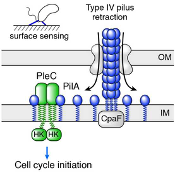Tactile sensing controls cell-cycle initiation in bacteria
A recent PNAS paper by the Christen group shows how pili function as tactile sensors and reports on the underlying signaling mechanism that interlinks surface attachment with cell-cycle initiation in bacteria.

Many bacteria stick to surfaces with the help of long protein-fibers termed pili that protrude from their cell surface. In their PNAS research article, the Christen group (Institute of Molecular Systems Biology) uncovered the molecular mechanism how pili function as tactile antennas to start the bacterial cell-cycle upon surface contact. Surface attachment induces depolymerization of pili filaments. The concomitant increase in pilin subunits within the inner membrane function as a stimulus to activate the second messenger cyclic di-GMP and trigger cell-cycle initiation. Furthermore, provision of a 17-amino acid synthetic peptide corresponding to the membrane portion of the pilin subunit mimics surface sensing, activates cell-cycle initiation, and inhibits surface attachment. Thus, synthetic peptide mimetics of pilin represent promising chemotypes to control biofilm formation and treat bacterial infections.